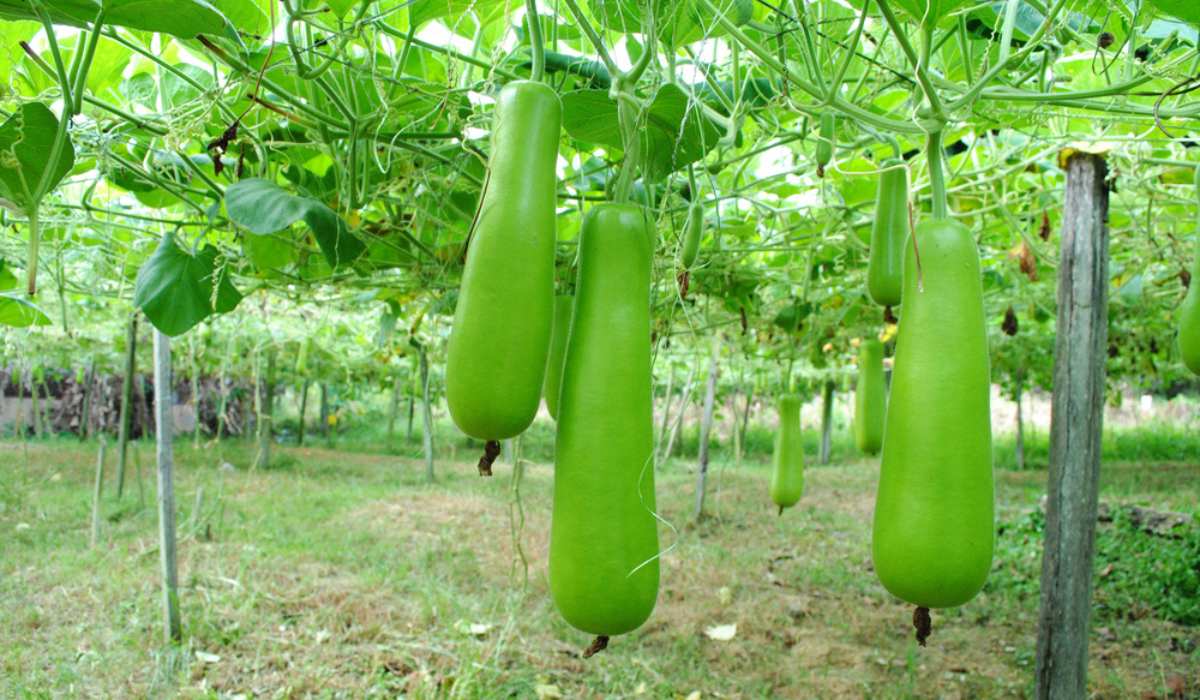
Bottle Gourd (Lagenaria siceraria)
General Information
- Common Names: Calabash, Lauki, Doodhi, Sorakaya.
- Family: Cucurbitaceae.
- Origin: Believed to have originated in Africa, it is now cultivated globally in tropical and subtropical regions.
- Uses: Used as a vegetable in cooked dishes, soups, and salads. Also utilized for making traditional musical instruments, containers, and decorative crafts.
Origin, Area, and Distribution
- Origin: Africa.
- Area: Widely grown in India, China, South Asia, and parts of Southeast Asia.
- Major Growing States in India: Uttar Pradesh, Bihar, Madhya Pradesh, Andhra Pradesh, Maharashtra, and Karnataka.
- Distribution: Cultivated in tropical and subtropical regions worldwide.
Climate
- Bottle gourd thrives in warm and humid climates.
- Temperature: Optimal range of 20–30°C.
- Rainfall: Requires 50–100 cm of well-distributed rainfall.
- Sensitive to frost; prefers long-day conditions for vegetative growth.
Soil
- Well-drained loamy or sandy loam soils rich in organic matter are ideal.
- pH: 6.5–7.5.
- Avoid waterlogging and highly saline soils.
Improved Varieties
- Arka Bahar: Uniform fruits, high yield.
- Pusa Summer Prolific Long: Cylindrical fruits, heat-tolerant.
- Pusa Summer Prolific Round: Suitable for summer cultivation, round fruits.
- CO 1: Early maturing, long fruits.
- Punjab Komal: High yield, tender fruits.
- Samrat: Long fruits, suitable for commercial farming.
Seed Rate: 2–4 kg per hectare. Higher seed rate for direct sowing and lower for transplanting.
Cultivation Practices
Time of Sowing
- Summer Crop: January–February.
- Rainy Season Crop: June–July.
Land Preparation
- Plough the field 2–3 times to obtain a fine tilth.
- Apply 10–15 tons of farmyard manure (FYM) per hectare during land preparation.
Transplanting Techniques
- Sow seeds directly or transplant seedlings.
- Prepare nursery beds with well-drained soil and FYM.
- Transplant 2-week-old seedlings to the main field.
Planting Distance
- Row-to-row: 2.5–3 m.
- Plant-to-plant: 60–75 cm.
Fertilizer Requirements (Per Hectare)
- Basal Dose: 100 kg N, 50 kg P₂O₅, 50 kg K₂O.
- Apply half the nitrogen and full phosphorus and potassium at planting.
- Top-dress the remaining nitrogen in 2–3 splits during the growing period.
Irrigation
- Requires frequent irrigation, especially during flowering and fruit development stages.
- Avoid waterlogging.
- Irrigate at intervals of 7–10 days during dry periods.
Weed Management
- Perform 2–3 manual weedings during the crop cycle.
- Mulching can help suppress weed growth and retain soil moisture.
Training and Pruning
- Train plants on a trellis or support system for better air circulation and fruit quality.
- Prune unnecessary lateral shoots to promote growth and yield.
Harvesting and Yield
- Harvesting:
- Harvest tender fruits before they mature fully.
- Regular picking encourages new fruit formation.
- Yield: 20–25 tons per hectare, depending on the variety and management practices.
Physiological Disorders
- Fruit Cracking: Caused by irregular irrigation or water stress. Management: Maintain uniform soil moisture levels.
- Poor Fruit Set: Due to high temperatures or poor pollination. Management: Ensure proper pollination by encouraging bee activity or manual pollination.
- Yellowing of Fruits: Result of nutrient deficiencies or pest infestations. Management: Apply balanced fertilizers and control pests effectively.
Pests and Diseases
Common Pests
- Red Pumpkin Beetle: Damages seedlings and leaves.Control: Apply neem-based pesticides.
- Fruit Fly: Lays eggs in developing fruits. Control: Use pheromone traps or neem extracts.
Common Diseases
- Powdery Mildew: White powdery patches on leaves. Control: Spray sulfur-based fungicides.
- Downy Mildew: Yellow spots on leaves with whitish growth underneath. Control: Use copper fungicides or resistant varieties.

